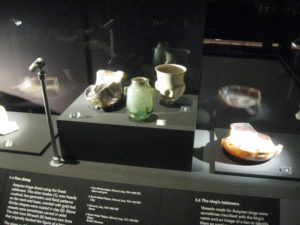We know almost nothing of him beside his claim to be ‘king of kings’ yet his reign – if we can believe his propaganda – was the most glorious Assyria had experienced and the scourge of his rivals and enemies. Nonetheless, within a few years of his death around 620 BC it had crumbled to nothing. The bombast of his sculptural monuments as well as the delicacy of his personal utensils culminate in a sad video that recalls even worse destruction wreaked on the remains by Islamic State.
How to choose a representative selection of images from the exhibition is a pleasant chore, recalling an imaginative presentation that lives up to the very best Neil MacGregor achieved during his tenure at the British Museum. Grey stone comes to life under lighting that represents clothing on the human figures or trees and flowing water in the glorious gardens of the palace. There are musical and other sounds to add to the illusion.
The gardens were really a zoological park, with lions kept for hunting as well as birds and water creatures. Travel by water is demonstrated too. Battle scenes do credit to the epics of Hollywood with executions that only Japanese cinema might attempt. Slaves bring tribute and the gods are celebrated. One frustration (for a photographer) was a reflection eliminating detail on the great king in a gesture of humility, carrying on his head a basket of soil for the rejuvenation of his land. It seems the desert was always at the door and required more than the periodic inundations to retain its fertility. Needless to say those gardens represented the most conspicuous consumption the ancient world had known.
Other small exhibits represent gods and animals; utensils of surprising delicacy as well as grandeur are displayed. The texts establish not only Ashurbanipal’s power but also his revenge on challengers or enemies. The Hollywood reference conjures up ideas of ‘The Godfather’.
The museum has spared nothing in matching the king’s self-image. As well as lighting the stone carvings there are evocations of the carpets on the palace floors and even the gallery floor has projections of a map of his realm.
Ashurbanipal’s final campaign is presented as a great success yet within a few years he was dead. The cause and the date of death are unknown. All that is certain is the withering away of the state he left, rendered the more pathetic by the video epilogue that, nonetheless, has a note of hope that restoration of the remains and artifacts may be possible.
In life he could proclaim with Shelley’s Ozymandias, ‘Look on my works, ye Mighty, and despair!’ yet this exhibition and the hope contained in co-operation between the British Museum and Iraqi archaeologists suggest all will not end as in the poem:
Nothing beside remains. Round the decay
Of that colossal wreck, boundless and bare
The lone and level sands stretch far away.










